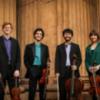
Any creative undertaking is bounded by certain constraints, such as the time you have to finish it or the fixed size of your canvas. You can argue whether these constraints impede or enhance creativity. Indisputably, though, our current times provide plenty of them: Musicians cannot rehearse in groups while individually sheltering in place, for example, and even when musicians play together over a video conferencing platform, the vagaries of internet connectivity can cause parts that should happen simultaneously to align imperfectly.
But on Saturday, Nov. 28, San Francisco’s Center for New Music (C4NM) presented four new works for string quartet — by Davide Verotta, Shawne Anell Workman, Monica Chew, and Allan Crossman — that were created with virtual-performance restrictions in mind. The Friction Quartet, with each member playing from their own home, streamed this intrepid program called “Composing in the Time of the Pandemic.”

Verotta’s Solitari solves the problem of performers not necessarily being able to play in sync by removing the expectation that they must. At any given time, one player served as the melodic point of reference, and the other players followed the lead to add layered accompaniment without everything necessarily aligning with perfect precision. The piece alternates between slow and fast sections, and opened with haunting, high harmonics. At least on my end, the fastest section revealed another peculiarity — for which neither the performers nor the composer were to blame — of performing over Zoom: My video wasn’t keeping up with my audio, causing trippy cognitive dissonance between sight versus sound. Regardless, beautiful melodic lines rotated between Friction’s members in this mostly pensive piece.
Workman’s Airwaves also eliminated the need for exact timing, albeit with different strategies. It opened with an unmeasured section of sustained, progressively layered pitches from which a beautiful, melancholy melody developed. A highly rhythmic section followed, but the composer explained that each player had a unique meter. These overlapping rhythms intrigued me, because I couldn’t understand just from listening how the vertical alignment was immaterial. Regardless, the piece concluded with a strategy similar to Verotta’s, with individual players leading with a melody or ostinato while the others imprecisely accompanied.

Visually, Chew’s Delayed Send replaced Zoom’s four squares of musicians with a stunning video montage. The images were breathtaking in and of themselves, and also fit the music like a glove. For example, an opening section gradually built, then landed upon a cadence of sorts. Perhaps because, according to the program notes, each player had their own tempo, there were deliberate bumps or fissures in this cadence. The corresponding image was of rocks — which, like a cadence, might symbolize stability — but the visual image, again like the cadence, shook or ruptured slightly. Delayed Send’s images ranged from nature scenes in the beginning, to provocative pictures of people, to images of mass production that matched a more rhythmic, mechanistic section in the music. Although I’m not sure what the intended narrative was here — or even if a narrative was intended at all — this piece sounded monumental or cinematic in scope.
Friction closed with Crossman’s Two Dances. The first, Rondo à Pollock, was inspired by the visual artworks of Jackson Pollock, which the quartet represented musically in sharp, angular lines. The second, City Dance, was modelled after a pastoral or country dance, but mimicked more robust sounds of urban life. Crossman described his method of dealing with the unreliable synchronicity of remote performance in terms of writing very specifically, then inviting the players to ad-lib.
Crossman also said that he was glad to have tried this compositional experiment, and he wonders whether composers will continue to play with the constraints of virtual performance even after the pandemic ends. Verotta similarly expressed enthusiasm for the challenge of throwing away typical constraints such as unisons and clear harmonic progressions. A few members of Friction, meanwhile, shared some challenges of rehearsing over Zoom. One said preparing this program made him all the more appreciative of live music.

Friction is a highly accomplished ensemble, and their sentiments are more than understandable. But it’s interesting that, while the performers seemingly regarded the constraints of performing in the pandemic as an impediment to their creativity, the composers regarded their constraints as more of an enhancement (or at least a novel challenge) to theirs.
But one can argue the point.
See for yourself in the video below:




